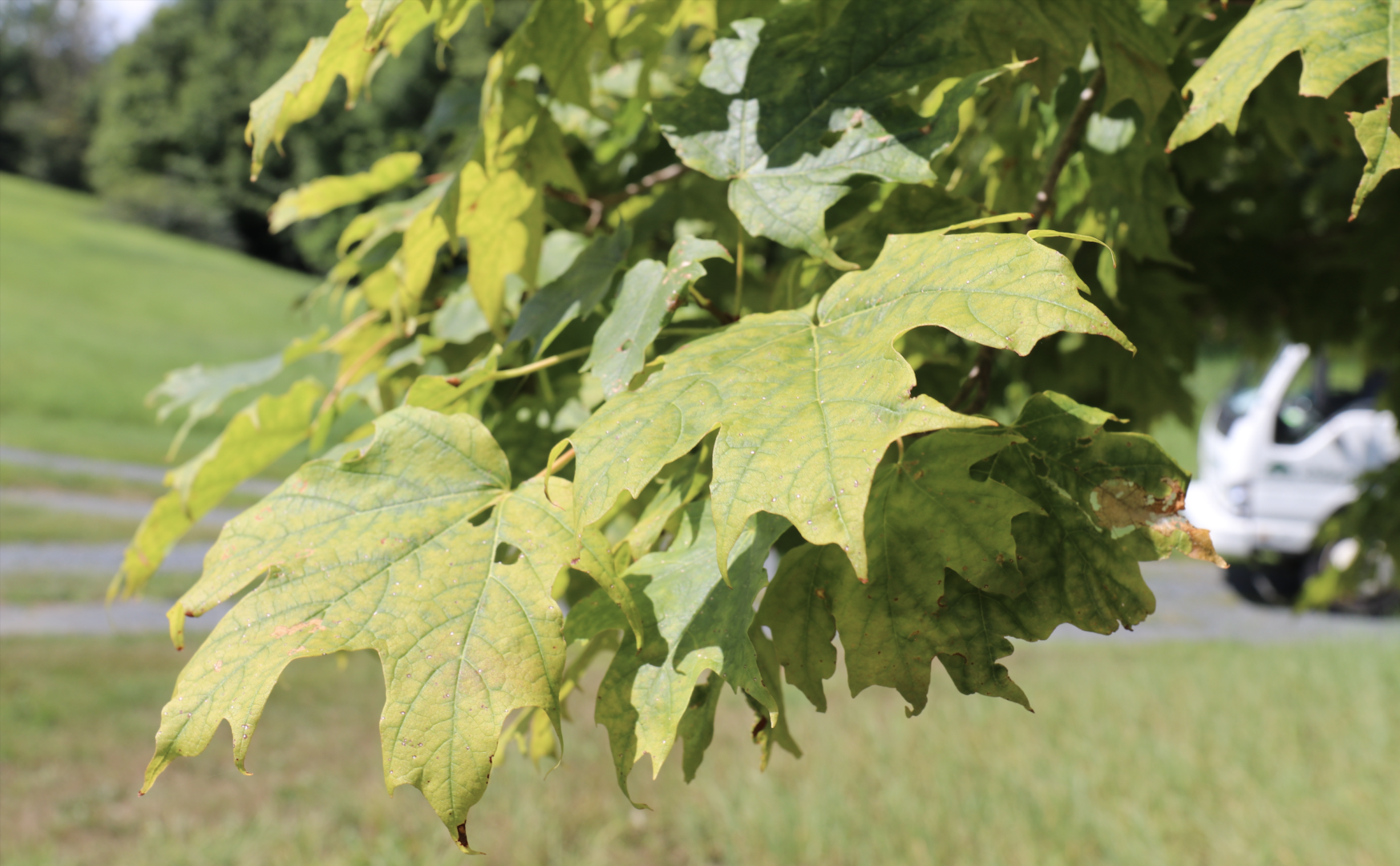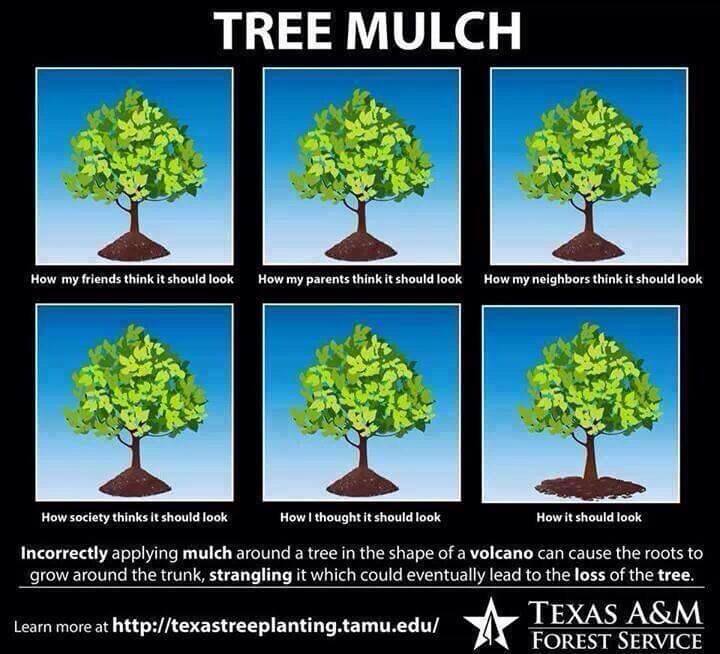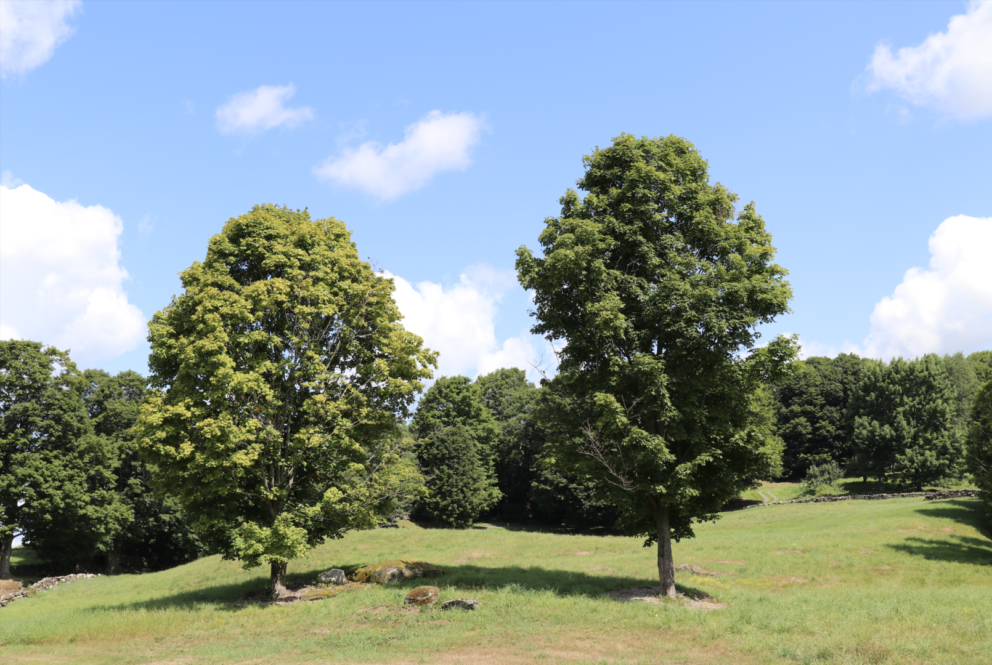In recent years we seem to be experiencing more severe droughts and more erratic wet spells during the growing season. Hot and dry summers open our trees up to many maladies including fine root damage, branch dieback, early leaf drop, and attack by many opportunistic pests and pathogens. Most home landscape soils inherently put trees at a disadvantage due to several key factors that are described below. The best way to combat these issues is to take a proactive approach that focuses on improving tree and soil health naturally. To accomplish this, we need to understand how the planted landscape differs from a forest setting and implement practices that help “make your trees feel at home”.

The two sugar maples in the photo above, are showing symptoms of environmental stresses. They are growing on shallow, compacted and dry soils. Both have had dead branches removed to improve their appearance, but continue to decline because of the poor soil conditions and nutrient deficiencies. The tree on the left and this close-up of its leaves show more severe chlorosis, the yellowish color that unhealthy trees can develop. It is best to be proactive and begin improving poor soil conditions before stress symptoms appear and decline sets in.
Water
One of the most important aspects of tree health and longevity in the landscape is providing a sufficient amount of water during the growing season. Drought stress is one of the most common predisposing factors of tree decline in the landscape. Without enough water, trees cannot photosynthesize effectively or absorb nutrients from the soil, and therefore cannot defend themselves against pest, disease or other environmental stressors adequately. The challenge is to make sure enough water actually reaches the tree before it is absorbed by competing vegetation.
Soil
There are many characteristics of landscape soils that contribute to heat and drought stress on planted trees. Soil compaction impedes water infiltration and reduces total pore space that limits water availability. Shallow, compact and poorly drained soils force the tree to concentrate roots very close to the surface, which are very susceptible to heat stress and desiccation. Most soil in the home landscape has been moved, graded, removed and replaced with subpar material lacking in biological diversity. Trees depend heavily on symbiotic relationships with countless soil microorganisms to access water and nutrients within the soil. The challenge is to amend, adjust and improve soil quality so that it can support a healthy underground ecosystem.
Landscape
Turf-dominated landscapes are a far cry from the rich organic forest soils where trees evolved to grow. Grass is a heavy competitor for water and nutrients, especially during periods of little rain. Manicured lawns also interrupt nutrient cycling by removing important inputs of organic matter. In the forest, the decomposition of leaves, branches and fallen trees create a rich humus that feeds the soil food web and provides all the nutrients needed for growth. The challenge is to balance the desire for beautiful turf with providing your trees with what they need to thrive.
What You Can Do
Watering periodically helps your trees through times of little rain and hot weather so they can continue to photosynthesize and defend themselves against environmental stressors. Slow and deep watering with a soaker hose or drip irrigation is the best way to saturate the soil well enough so that it percolates through the turf and into the tree roots. Light watering is mostly absorbed by turf and only promotes shallow roots and increases the risk of heat and drought damage.
Contact a plant health care professional to ask about mulch rings and root zone soil treatments to revitalize soil health, improve water and nutrient availability, and help your most valuable trees through the toughest time of the growing season. Plant health care professionals have both the knowledge and the tools to implement these services, described below.

Mulch Ring
Installing a mulch ring around the base of your tree is the best way to mimic forest soil and really make your tree feel at home. Mulch not only protects the base of the tree from mechanical damage, but also buffers against heat and cold, adds organic matter to the soil, feeds soil microorganisms, retains moisture, and provides nutrients. They can be installed any time during the growing season, and should be maintained yearly to prevent weed and grass growth. Don’t fall victim to the infamous “mulch volcano” that is so common in the landscape today. Excessive mulch around the base of a tree can cause rot and encourage pests to damage the stem. It is imperative that the mulch depth and position near the trunk is correct. Improperly installed mulch can cause serious problems, so please reach out to a professional.
Root Zone Injection
Root zone injection is a technique that uses a soil probe to inject a liquid solution directly to the root zone of the tree using a hydraulic pump. This method quickly and efficiently delivers water, nutrients, biostimulants, and beneficial soil organisms to the tree roots to revitalize the soil food web.
Soil Surface Drenches
Similar to the root zone injection, we also perform soil surface drenches to deliver the same biostimulants into a broader area such as mulch beds or large plantings where the soil probe may be disruptive.
Both stress-relieving soil treatments contain food for microbes and soil conditioners to help retain moisture, improve the permeability of compact soils and promote soil biology and can be done multiple times throughout the growing season.
Remember, trees are not so different from you and me. They also need the essentials of life in order to thrive and stay healthy year after year. The next time you’re hot and tired on a dry summer day, imagine how your trees “feel”!
Definitions
Desiccation
The removal of moisture.
Humus
The organic component of soil, formed by the decomposition of leaves and other plant material by soil microorganisms.


